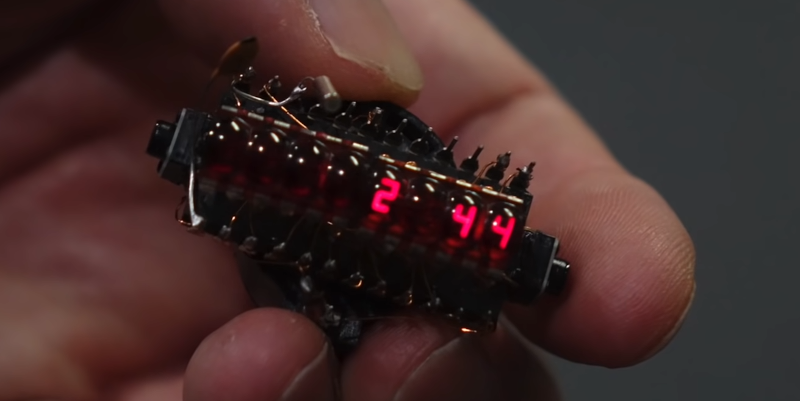[CuriousMarc] is nothing if not curious. Finding some old TI timekeeping chips to reverse engineer, he set out to make a clock using old-fashioned “bubble LEDs.” You can see the result of his tinkering in the video below. For the uninitiated, bubble LEDs are 7-segment LEDs with magnifying bubbles over each digit. These were popular in calculators, watches, and other places that used LEDs before LCDs largely displaced them.
The history of these has to do with the power required to light an LED. You don’t technically need a magnifying lens, but larger LEDs take more power. These displays were relatively low power and used tiny LEDs with light pipes to make each dot a full segment. The lens made the segments larger and easier to see.
Beyond the TI chip and HP displays, there isn’t too much else needed. [Marc] just wired the whole thing using the IC as a substrate. Sort of dead bug construction using enameled wire. At first, it didn’t work but it turned out to be a battery issue. The device really wanted 2.5 V and not the 3 V provided by the battery. The solution required a little detective work.
We know this isn’t a very practical project, but we love seeing this old tech again and while the dead bug construction isn’t beautiful, there is something appealing about the look of it. Maybe one day people will build steampunk things and discopunk will be for the 1970s?
We’ve seen bubble LED projects before. If you want something more in a watch form factor, that exists, too.
















If you do have working HP bubble displays, please don’t use them for projects like this!
They are needed for restoration of HP calculators from the same period.
See hpmuseum.org
pfft
What about the poor old TI-30s and 57s and such? They need bubble LEDs too!
if they are so rare and hard to find i’m sure someone could do a facsimile with some smd leds and some 3dprinter/resin magic as replacements….
AFAIK “someone” hasn’t.
A man in Germany, who is quite knowledgeable in HP calculator repairs, and has made a module that replaces the ACT chip, no longer supplies readout rebuilds because he can’t obtain the bubble displays needed.
But HP calculator community will be very grateful to someone succeeds in building a good replacement. (Or someone who finds a locker full of NOS displays. )
They are still available for sale as NOS. Just expensive.
Jameco has 6 digit one on clearance for $2.95 USD
Or, if it’s someone else’s property, they can and will do whatever they want with it. If you need this specific display and want to use it to restore a calculator then make an offer to purchase it from someone who has them at a price that they are willing to part with it for, otherwise they wont and complaining about what people do with their property is pointless.
CuriousMarc restores enough vintage items to play with a couple of vintage parts…
I have a bubble display in the junk box from the 1970’s I think. Never soldered to. I don’t think it’s HP.
It made as a 9 digit but the left digit isn’t fitted. Everything else is there for like the bubble – just no LEDs. So it’s an 8 digit display in a 9 digit format.
I’m pretty sure someone made a watch with these before this. However, it’s pretty amazing how many different projects there are only to display the time of day. Seriously, the article tag “clock” has an obscene number of entries for time telling projects.
“and while the dead bug construction isn’t beautiful”, omg.. how DARE YOU!
Back in 1976, I attempted to build my first digital clock from a kit. I royally screwed up the 6-digit LED multiplex display board while attempting to solder 6 individual LED display digits to it. The kit sat for months that way. One day I realized I could buy an 8-digit calculator bubble display from Radio Shack to display the time. 8 digits allowed two extra – space between the hours and minutes, and minutes and seconds. I soon had a working, though with a tiny display, digital clock that I used as my bedroom clock for a couple years after that.
The original Star Wars light sabers used these displays held in the mounting clamp of the Graflex flash holder. Not connected to anything, just there to have something there.
They used bubbles to magnify tiny displays. I remember getting one from somewhere, perhaps Poly-Pak, and then realizing not too useful unless you were multiplexing.